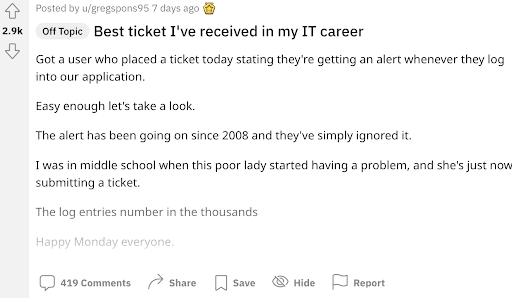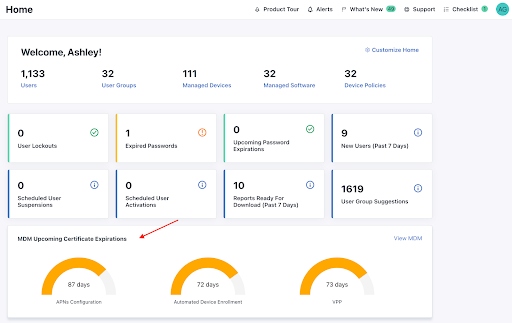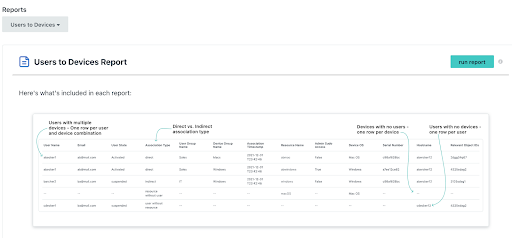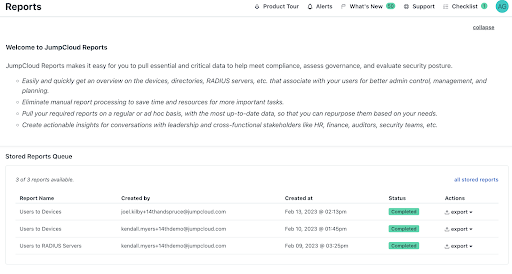Behind every admin is an analytical mind, a stockpile of memes, and a stack of tickets they don’t know whether to laugh or cry about.
Undoubtedly, it takes a uniquely skilled individual to troubleshoot incoming requests, ensure systems don’t come crashing down, and stay on top of the plethora of IT data points that are essential for managing daily operations.

Besides setting up event automations, one of the easiest ways admins can increase efficiency is to choose user-friendly tools for their stacks. The average IT admin is dependent on a dizzying array of single-purpose solutions — Active Directory, MSMs, RMMs, etc. — that hoard data in multiple locations.
The JumpCloud Directory Platform is a powerful tool that unifies several of the security and identity & access management tools admins rely on most into one centralized location. In the admin portal, IT managers can find the data they need to solve both everyday and less frequent challenges with ease.
If you’re not familiar with JumpCloud, or you want to learn more about the platform’s features, keep reading. Below we’ll highlight some common data retrieval situations admins may find themselves navigating on the job. We’ll also share where to find relevant information in the admin portal.
Let’s get started:
7 Common IT Admin Situations You Can Solve with Directory Insights and Reporting
Upon logging into the JumpCloud admin portal, you’ll notice the homepage contains a variety of widgets detailing various points of interest.
The top of the page lists the organization’s total number of users, managed devices, managed policies, and more — no need to hunt for basic info.
Below these stats, you’ll find several at-a-glance data points that provide a bird’s-eye view of data related to common queries. With that said, the platform’s in-depth information can be found in Directory Insights and Reports, as indicated in the screenshot below:

The JumpCloud Directory Platform’s reporting functionalities eliminate the need to hunt down device, policy, and authentication information. Simply select Directory or Reports from the Insights menu to reveal a variety of reporting and filtering options.
OK, now that we’ve discussed where to find the data, let’s dive into those common admin scenarios:
1. Select network users can’t access the on-site server.
For many admins, troubleshooting is the meat and potatoes of the role. According to a recent survey by Robert Half Technology, workers spend about 22 minutes each day dealing with some type of IT issue.
Oftentimes, these complaints are easy for admins to solve. Incidents like forgotten passwords, slow performance, and deleted files can be remedied through a simple chain of procedures.
But the culprit behind isolated network connectivity problems may be less obvious to many IT managers.

If the majority of workers are accessing the server without a problem, you’re most likely dealing with an incorrect permission structure.
In this case, we recommend checking Users to LDAP Servers in Reports to determine if anyone was inadvertently placed in the wrong group. If so, the solution is to modify the affected users’ group settings.
2. You onboarded a high number of new users within a short period.
Whether it’s a startup on a hiring spree post funding or an enterprise company navigating an acquisition, onboarding a large number of new employees can be stressful for everyone.
New workers often feel overwhelmed having to quickly absorb significant information in several areas. HR sometimes feels pressure to ignite enthusiasm in the company mission, while setting up the new hires for success.
And admins feel the heat of adding time-consuming configurations to their already busy schedules! For these reasons, it’s not uncommon for risky security oversights to happen.

With JumpCloud, admins can double-check against potential onboarding errors by referring to their new user stats on the admin portal homepage. Simply scan your widgets to review password statuses, weekly MFA enrollments, and more.
Additionally, refer to JumpCloud Reports to double-check access permissions.
Several of our customers have said they were surprised to find users with incorrect access permissions via Reports. Again, we’re all human and these things happen! The key is to identify them as quickly as possible and then automate them.
3. Your MDM certificates will soon expire (you’re just not sure when).
Have you ever struggled to keep up with your certificate expiration dates? Should your organization’s certificate expire, operations will come to a screeching halt.
In addition to the legwork of reconfiguring with a new certificate, the event often presents a sizable financial burden as well. With JumpCloud you never have to worry about tracking your certificate expiration date again.

Simply glance at your MDM Upcoming Certificate Expirations on your admin portal homepage. The colorful illustrations highlight how many days left your organization has for APNs Configuration, Automated Device Enrollment, and VPP. Easy peasy, right?
4. Some users aren’t receiving their updates.
Have you ever had a user reach out saying they didn’t receive your organization’s latest software update.
Surprisingly, it’s not uncommon for some users to indefinitely ignore MDM updates because they are so engrossed in daily tasks. This is where Directory Insight’s MDM Commands Results Filter comes in handy.

5. You’re wasting time repeatedly monitoring specific events.
Depending on one’s organization’s industry, security posture, and unique policies, an admin may find themself monitoring specific events multiple times a day. Automating scripts is a powerful tool for catching specific data points outside of the norm.
JumpCloud empowers admins to set up their own filtered reports that query endpoints on the cadences of their choice with its API. For example, say a user is locked out after several failed login attempts. Directory Insights contains an event around each attempt. Should they desire, the admin could create a report that notifies them once someone has experienced five such incidents.

Alternatively, maybe OS patch management reveals 10 devices are out of compliance with the organization’s current patch policy. The admin can use JumpCloud Reports to reveal which software versions the devices are running and the last time the users updated their patches. These are just a couple of examples where custom automations can catalyze action plans that increase efficiency, save time, and improve security.
6. Encountering oversights because of transitory work cultures.
Another common issue we see many admins facing today is transitory work cultures. Contractors finish projects, workers switch departments, and temporary hires find work elsewhere in the time before the ink is dry.
Similar to our onboarding scenario, it’s not unusual for devices to get lost in the daily grind. Use JumpCloud’s Users to Devices report for a quick snapshot of who is no longer using their assigned devices.

Fun fact: Many of our admins run this report on a daily basis for the peace of mind it provides. Actually, one of our clients runs about 20 of these reports per day, taking advantage of a specific automation configuration that runs the report in a CSV/JSON format that reveals the numbers that matter most to them. All downloaded reports can be found in the Stored Reports Queue located at the top of the Reports Page or the Stored Reports Page.
7. Your external compliance auditor has requested control stats.
Few aspects of the admin role are capable of inciting such visceral levels of dread than IT compliance regulations and standards. Why?
Probably because most admins received minimal IT compliance education, if any at all. Throw in a severe time crunch, certifications fees in the tens of thousands of dollars, and a substantial list of controls to implement, and you have a recipe for overwhelm.
The good news is JumpCloud allows admins to maintain audit trails that prove adherence to regulations and standards. Whether preparing for an internal or external audit, admins can download reports that track:
- Users to Devices
- Users to Directories
- Users to LDAP Servers
- Users to RADIUS Servers
- Users to SSO Applications
- Users to User Groups
- Browser Patch Management
- OS Patch Management

Make Work Easier with Directory Insights and Reporting
The JumpCloud Directory Platform allows admins to manage passwords, users, events, MDM patches, and more from one dashboard. Our mission is to provide our customers with frictionless access to the tools, data, and automation capabilities they need to get everything done with less stress.
Ready to experience the JumpCloud difference for yourself?
Sign up for a free account for up to 10 devices and 10 users.
Or chat with peers in our community to get the inside scoop on JumpCloud.




